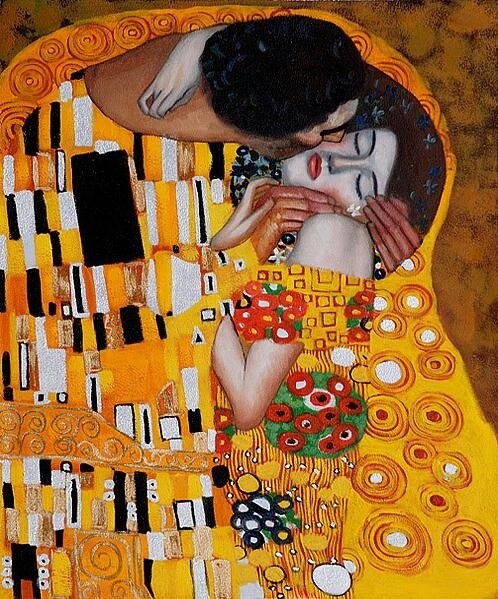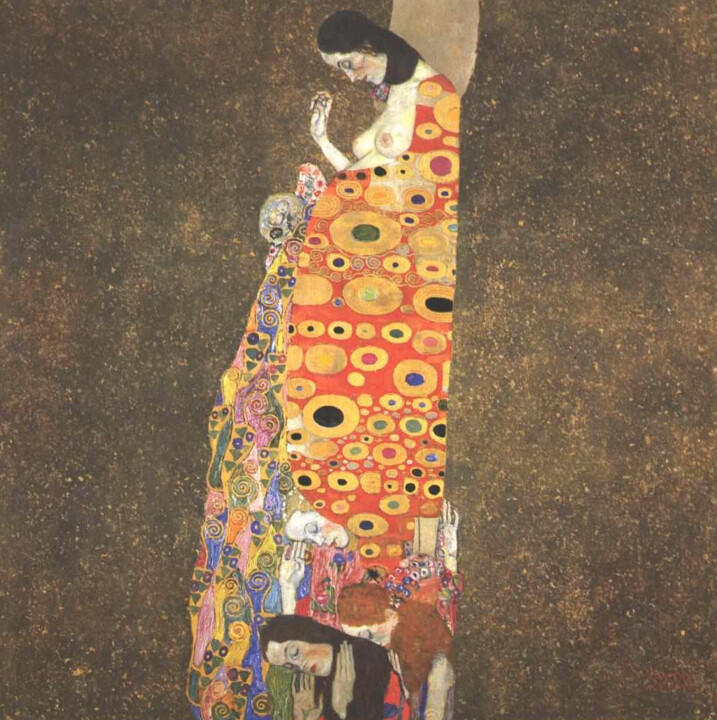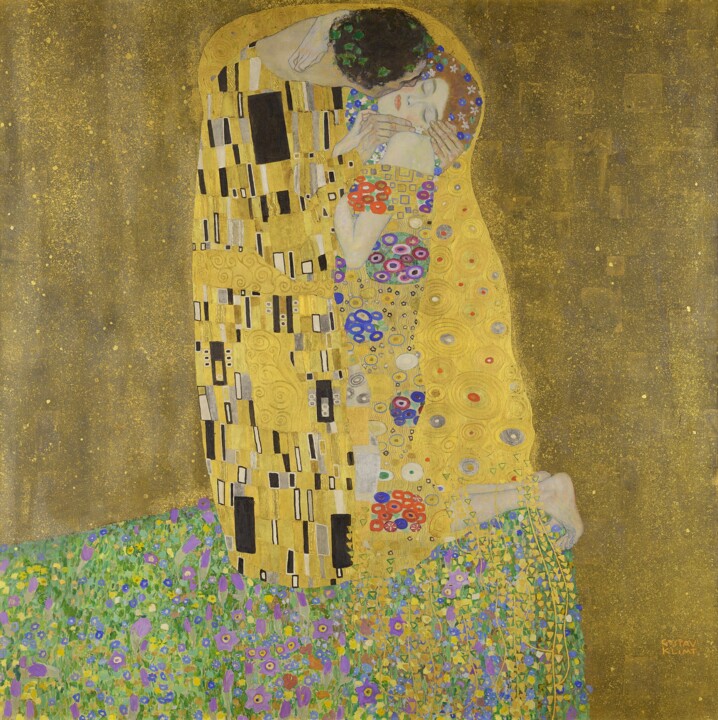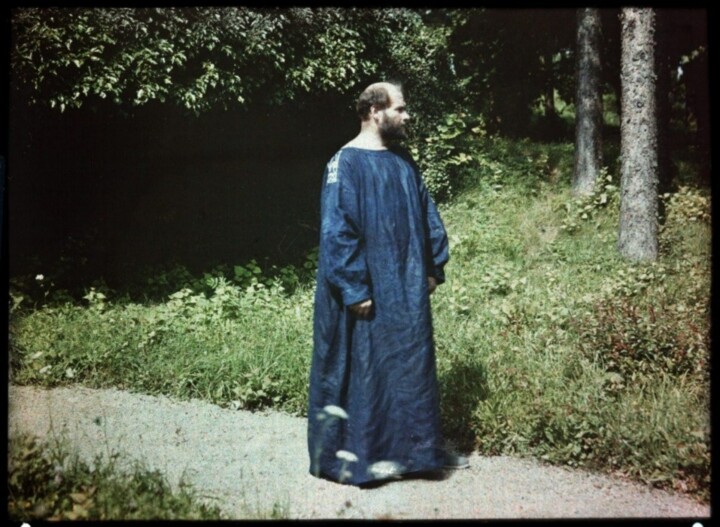 Gustav Klimt 1910, plaque autochrome-Lumière, photo taken by Friedrich Walker
Gustav Klimt 1910, plaque autochrome-Lumière, photo taken by Friedrich Walker
Who was Gustav Klimt?
Gustav Klimt was an Austrian painter who lived from 1862 to 1918. Klimt is perhaps best known for his decorative and highly ornamental paintings, which often feature shimmering gold leaf and intricate patterns. He drew inspiration from a variety of sources, including Byzantine mosaics, Japanese prints, and the natural world.
One of Klimt's most famous works is "The Kiss," a painting that depicts a couple embracing against a background of swirling patterns and gold leaf. The painting has become an iconic symbol of love and romance, and is widely reproduced and imitated in popular culture.
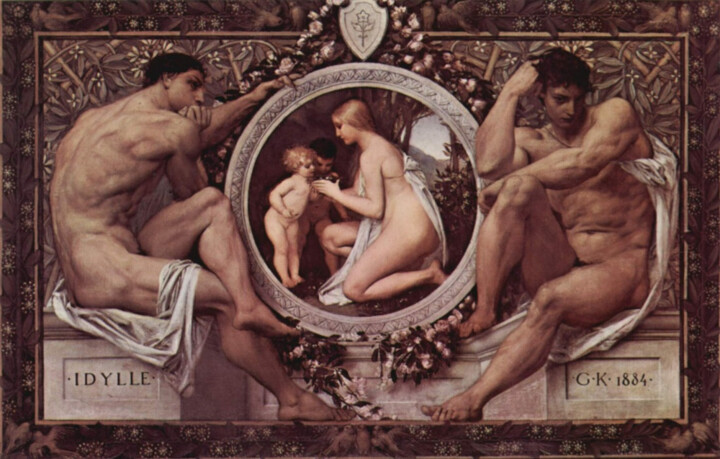 Gustav Klimt - Idyll, 1884. Oil on canvas. Vienna Museum, Vienna, Austria
Gustav Klimt - Idyll, 1884. Oil on canvas. Vienna Museum, Vienna, Austria
Despite his success and popularity during his lifetime, Klimt was also a controversial figure. His use of nudity and erotic imagery in his paintings was often considered scandalous, and he faced criticism from more conservative members of the art world.
Today, Klimt is widely recognized as one of the most important artists of the 20th century, and his work continues to be celebrated and admired by art lovers around the world.
The Life and work of Gustav Klimt
Gustav Klimt was an Austrian painter who lived from 1862 to 1918. He was born in Baumgarten, near Vienna, into a family of artists, and showed an early talent for drawing and painting.
Klimt attended the Vienna School of Arts and Crafts, where he studied under the painter Franz von Matsch. He went on to become a successful painter, known for his highly decorative, ornate style and use of gold leaf.
Klimt's early work was influenced by the classical traditions of Western art, but he soon began to experiment with new forms and styles. He became a founding member of the Vienna Secession, a group of artists who aimed to break away from the traditional styles of the academic art world and promote a more modern, avant-garde approach to art.
Throughout his career, Klimt produced numerous works of art, including portraits, landscapes, and allegorical paintings. He is perhaps best known for his "Golden Phase," a period in his career during which he made extensive use of gold leaf in his paintings. In this work, Klimt combines elements of both Art Nouveau and Symbolism to create a highly stylized, almost surrealistic depiction of the scene.
In addition to his paintings, Klimt was also a skilled draftsman and produced numerous drawings throughout his career. Many of his drawings are highly detailed and feature intricate patterns and designs.
Klimt's personal life was somewhat mysterious, and little is known about his relationships or his inner thoughts and feelings. He was known to have had numerous romantic relationships throughout his life, and some of his paintings have been interpreted as expressing his own desires and fears.
Klimt died in 1918, during the Spanish flu pandemic, at the age of 56. Despite his relatively short career, he is widely recognized as one of the most innovative and influential artists of the 20th century, and his work continues to inspire artists and designers to this day.
Klimt’s Golden phase
Gustav Klimt's "Golden Phase" refers to a period in his career during which he made extensive use of gold leaf in his paintings. This period is generally considered to have begun in the late 1890s and lasted until around 1908.
During this time, Klimt's paintings were characterized by their elaborate, decorative style, featuring intricate patterns and ornate motifs rendered in gold leaf. The use of gold leaf was particularly significant, as it gave Klimt's paintings a luxurious, almost otherworldly quality that was entirely unique.
Some of Klimt's most famous works from this period include "The Kiss," "Portrait of Adele Bloch-Bauer I," and "Judith and the Head of Holofernes," all of which feature his signature use of gold leaf and intricate patterning.
 Gustav Klimt - Judith II (Salome), 1909. Oil on canvas. 178 × 46 cm. Ca' Pesaro – International Gallery of Modern Art, Venice, Italy
Gustav Klimt - Judith II (Salome), 1909. Oil on canvas. 178 × 46 cm. Ca' Pesaro – International Gallery of Modern Art, Venice, Italy
The reasons behind Klimt's "Golden Phase" are not entirely clear, but many art historians have speculated that it was influenced by a number of factors, including his interest in Byzantine art and his desire to create a new, more decorative style that broke away from the traditional, academic approach to painting.
Overall, Klimt's "Golden Phase" was a significant period in his career, and his use of gold leaf and decorative motifs has had a lasting impact on the art world, inspiring countless artists and designers to experiment with new forms of ornamentation and decoration in their work.
Critical success
Klimt achieved critical success during his career, although his innovative and controversial approach to art was not always embraced by the establishment.
Klimt's work was first recognized in the late 19th century, when he began receiving commissions for public buildings and private residences in Vienna. His paintings were also exhibited in major galleries and exhibitions, and he became known for his highly decorative, ornate style.
 Gustav Klimt, 1914. Photo taken by Josef Anton Trčka
Gustav Klimt, 1914. Photo taken by Josef Anton Trčka
However, Klimt's art was not universally accepted. Some critics felt that his work was too sensual and erotic, while others found it too decorative and lacking in substance. Klimt's use of gold leaf and other unconventional materials was also seen as controversial by some.
Despite these criticisms, Klimt continued to gain recognition and acclaim throughout his career. He was awarded numerous prizes and honors, including the Antwerp Grand Prize in 1895. For his contributions to art, Emperor Franz Joseph of Austria awarded Klimt the Golden Order of Merit in 1888. Also, the Universities of Munich and Vienna made him an honorary member.
Today, Klimt is widely recognized as one of the most innovative and influential artists of the 20th century.
Founding the Vienna Secession
Gustav Klimt was a founding member of the Vienna Secession, a group of artists and designers who aimed to break away from the traditional styles of the academic art world and promote a more modern, avant-garde approach to art.
In 1897, Klimt, along with a group of like-minded artists, designers, and architects, founded the Secession movement in Vienna. The group organized exhibitions, published a magazine, and held lectures and discussions on art and design.
Klimt played a key role in the Secession movement, serving as its first president and designing its iconic building, which was completed in 1898. The building, known as the Secession Building or the Beethovenfries, is notable for its modernist design and its use of glass and metal.
The Vienna Secession movement was characterized by its emphasis on individualism and artistic freedom, and its rejection of the traditional, academic approach to art. The movement had a significant impact on the development of modern art in Europe, influencing many artists who followed in its wake.
Overall, Klimt's founding of the Vienna Secession was a major contribution to the art world, paving the way for a more modern, experimental approach to art and design that continues to influence artists today.
Important art by Gustav Klimt
Gustav Klimt created many important works of art during his career, but some of his most famous and influential pieces include:
The Kiss - This painting, completed in 1908, depicts a couple embracing in a field of flowers, with swirling patterns and gold leaf surrounding them. It has become an iconic symbol of love and romance, and is one of Klimt's most famous works.
 Gustav Klimt - The Kiss, 1907–1908. Oil on canvas. 180 × 180 cm. Österreichische Galerie Belvedere
Gustav Klimt - The Kiss, 1907–1908. Oil on canvas. 180 × 180 cm. Österreichische Galerie Belvedere
Portrait of Adele Bloch-Bauer I - This portrait, completed in 1907, depicts Adele Bloch-Bauer, a wealthy society woman who was a patron of the arts. The painting is notable for its use of gold leaf and intricate patterns, and has become one of Klimt's most famous portraits.
 Gustav Klimt - Portrait of Adele Bloch-Bauer I, 1907. Oil, silver and gold on canvas. 140 × 140 cm . Neue Galerie New York
Gustav Klimt - Portrait of Adele Bloch-Bauer I, 1907. Oil, silver and gold on canvas. 140 × 140 cm . Neue Galerie New York
Judith and the Head of Holofernes - Completed in 1901, this painting depicts the biblical story of Judith beheading the Assyrian general Holofernes. The painting is notable for its sensuality and eroticism, and has become one of Klimt's most famous works.
 Gustav Klimt - Judith and the Head of Holofernes, 1901. Oil on canvas. 84 x 42 cm. Österreichische Galerie Belvedere
Gustav Klimt - Judith and the Head of Holofernes, 1901. Oil on canvas. 84 x 42 cm. Österreichische Galerie Belvedere
Danaë - Completed in 1907, this painting depicts the mythological figure Danaë, who was said to have been impregnated by Zeus in the form of a shower of gold. The painting is notable for its use of gold leaf and intricate patterns, and is considered one of Klimt's most beautiful and sensual works.
 Gustav Klimt - Danaë, 1907. Oil on canvas. 77 × 83 cm. Leopold Museum, Vienna
Gustav Klimt - Danaë, 1907. Oil on canvas. 77 × 83 cm. Leopold Museum, Vienna
Beethoven Frieze - Completed in 1902, this large-scale painting was created as part of a decorative scheme for the Secession Building in Vienna. It depicts the story of Beethoven's Ninth Symphony, and is notable for its use of vivid colors and swirling patterns.
Legacy
Gustav Klimt's legacy has had a significant impact on the art world and continues to influence artists today. He was a pioneer of the Art Nouveau movement and his work was characterized by its decorative and ornamental style.
Klimt's use of gold leaf in his paintings was particularly innovative, and it inspired many other artists to experiment with new materials and techniques. His emphasis on the decorative aspect of art also helped to pave the way for the development of the Art Deco style that followed.
Klimt's paintings were also notable for their eroticism and sensuality, which was controversial in his time but has since become widely accepted as a legitimate subject matter in art. His work has been a major influence on the development of the modern figurative art movement, particularly in the way that artists approach the human body.
 Gustav Klimt - The Three Ages of Woman, 1905. Oil on canvas. 180 × 180 cm. Galleria Nazionale d'Arte Moderna, Rome, Italy
Gustav Klimt - The Three Ages of Woman, 1905. Oil on canvas. 180 × 180 cm. Galleria Nazionale d'Arte Moderna, Rome, Italy
The popularity of Klimt's paintings, particularly "The Kiss," has also had a significant impact on popular culture. His work has been widely reproduced and imitated in fashion, advertising, and other media, and has become an iconic symbol of beauty, love, and romance.
Overall, Klimt's legacy as an artist is one of innovation, creativity, and boundary-pushing. His work continues to inspire and captivate art lovers around the world, and his influence can be seen in the work of countless artists who have followed in his footsteps.
In 2013, was founded The Gustav Klimt Foundation, dedicated to the preservation and promotion of the artistic legacy of Gustav Klimt. The main mission of the Gustav Klimt Foundation is to collect, research, and exhibit Klimt's artwork, as well as to provide educational programs and publications about his life and work. The foundation also supports the conservation and restoration of Klimt's works, as well as the acquisition of new pieces for their collection.
Through its activities, the Gustav Klimt Foundation seeks to deepen public understanding and appreciation of Klimt's significant contributions to the world of art and culture, both in Austria and around the world.
Cultural influence
Gustav Klimt's cultural influence has been far-reaching, extending beyond the art world to impact fashion, design, and popular culture. His use of decorative motifs, particularly gold leaf, has inspired countless designers and artists in fields ranging from fashion to interior design.
Klimt's emphasis on sensuality and eroticism in his paintings has also had a lasting impact on popular culture. His work has been widely reproduced and referenced in fashion, advertising, and other media, and has become a symbol of beauty and romance.
 Gustav Klimt - Hope II, 1907–08. Oil, gold, and platinum on canvas. Museum of Modern Art, New York
Gustav Klimt - Hope II, 1907–08. Oil, gold, and platinum on canvas. Museum of Modern Art, New York
One of Klimt's most famous paintings, "The Kiss," has been particularly influential. It has been reproduced in countless forms, from jewelry to home decor, and has become an iconic image of love and intimacy.
Klimt's legacy has also had an impact on the art world itself. His innovative use of materials and techniques, as well as his exploration of themes such as sexuality and psychology, have inspired generations of artists who have followed in his footsteps.
Overall, Klimt's cultural influence can be seen in a wide range of fields, from fashion to fine art, and his work continues to inspire and captivate audiences around the world.
Interesting facts about Gustav Klimt
One interesting fact about Gustav Klimt is that he often incorporated hidden or secret symbols into his paintings. For example, in his famous painting "The Kiss," there is a small snail depicted in the lower right-hand corner of the painting. Many art historians believe that the snail symbolizes the female genitalia, adding a subtle layer of eroticism to the painting.
Another interesting fact was that Klimt was known for his eclectic fashion sense. He was often seen wearing long flowing robes and sandals, and was particularly fond of a blue smock that he wore while working. Klimt was also known to wear a variety of accessories, including rings, bracelets, and pendants, many of which he designed himself.
In addition to his fashion sense, Klimt was also a lover of cats. He was often seen with his beloved pet cat, Katze, who he reportedly adored and would sketch and paint regularly.
Klimt also often used motifs from ancient Greek and Egyptian art in his work, such as the use of spirals and meanders, which were believed to represent eternity and the cyclical nature of life.
Another interesting fact is that Klimt was a member of a Masonic lodge in Vienna, and some art historians have speculated that Masonic symbolism may be present in some of his work. For example, the use of triangles and the depiction of sphinxes in his painting "The Beethoven Frieze" has been interpreted by some as referencing Masonic beliefs and ideals.
Overall, Klimt's use of symbolism adds a layer of depth and complexity to his work, and has contributed to his enduring popularity among art enthusiasts and scholars.


 Selena Mattei
Selena Mattei

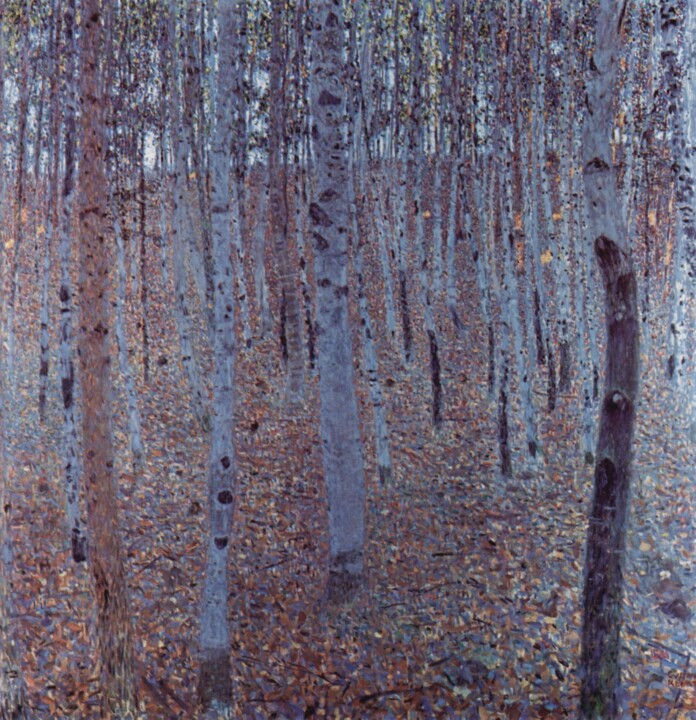
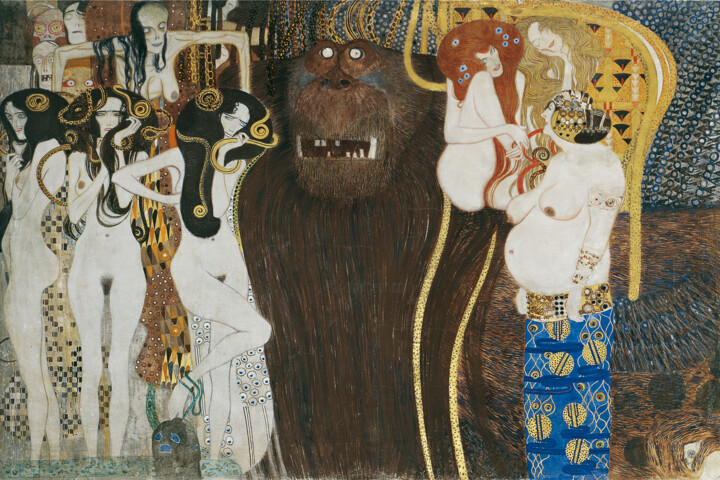
_-_image.jpg)

